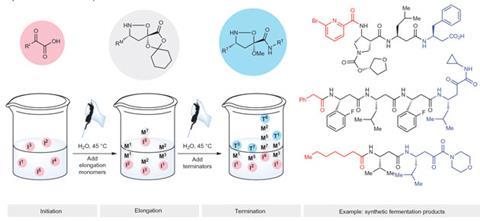Researchers hope simple system to build thousands of peptides without enzymes, cells or reagents will be accessible to all
You too can create thousands of new compounds and screen them for a desired activity. That is the promise of a novel approach to building chemical libraries, which only requires simple building blocks in water, without any additional reagents or sample preparation.1
Jeffrey Bode from ETH Zurich and his co-worker Yi-Lin Huang took inspiration both from nature’s non-ribosomal peptide synthesis and from click chemistry. Nature uses specialised non-ribosomal enzymes to create a number of unusual peptides outside the normal paths of protein biosynthesis including, for instance, pharmaceutically relevant peptides like the antibiotic vancomycin. Bode and Huang have now produced these sorts of compounds without cells or enzymes, simply relying on the right chemistry.
In 2006, Bode’s group developed a new type of reagentless coupling reaction that produces amide bonds from a reaction between an a-ketoacid and a hydroxylamine.2 In this reaction, carbon dioxide is eliminated as an amine nitrogen takes the place of the carboxylate group, resulting in the characteristic peptide link that holds together the amino acid building blocks in all proteins and peptides.

To build their combinatorial library, Bode and Huang used three types of building blocks, namely initiators that offer only the a -ketoacid functional group (I), chain elongator monomers that have a reactive hydroxylamine group (M) and a hidden a-ketoacid group that only becomes reactive when the hydroxylamine has hooked up to another building block, and finally a terminator block that has only the hydroxylamine group (T).
These basic types can form chains of different lengths such as IMT, IMMMMT and so on. Appending functional side chains to the building blocks, the researchers could create further variety. For their proof-of-principle work, they used 23 different building blocks to create around 6000 new compounds. Screening these for activity as inhibitors of a hepatitis C viral protease, they identified one compound with promise.
Given the simplicity of the process and the absence of toxic reagents and by-products, Bode anticipates that it could even be widely used by non-chemists. ‘Our idea is to provide a quick way to make bioactive molecules just by mixing the components in water,’ Bode explains. ‘We would like to use this as a platform for chemistry that anyone can do, including scientists in other fields, high school students and farmers. Anyone could prepare libraries in a few hours with a micropipette, explore different combinations of building blocks and culture conditions along with simple assays to find novel molecules.’
‘Huang and Bode show how the generation of specific and designable compound collections can be streamlined to the point that one doesn’t need to be a chemist to generate the collection,’ says Samuel Gellman from the University of Wisconsin at Madison, US. ‘I believe that this achievement is unique, and that many at the fringes of the chemistry community and beyond will find the promise of this work to be very alluring.’












No comments yet